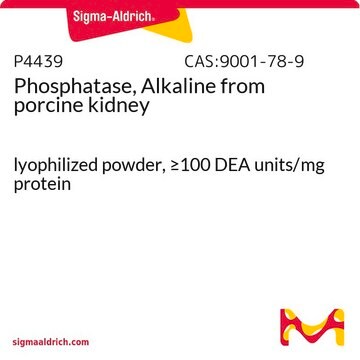P4069
Phosphatase, Alkaline from Escherichia coli
buffered aqueous glycerol solution, 20-50 units/mg protein (in glycine buffer)
Synonym(s):
Orthophosphoric-monoester phosphohydrolase (alkaline optimum)
About This Item
Recommended Products
biological source
Escherichia coli
Quality Level
form
buffered aqueous glycerol solution
specific activity
20-50 units/mg protein (in glycine buffer)
foreign activity
DNase, RNase, none detected
Storage temp.
−20°C
Looking for similar products? Visit Product Comparison Guide
Application
- in fluorometric assay to determine its enzyme activity
- in the dephosphorylating enzyme cocktail for dephosphorylation of peptides
- in treating the nerve and HL60 cell lysate for β-hydroxy β-methylglutaryl-Coenzyme A (HMG-CoA) reductase activity
Biochem/physiol Actions
Caution
Unit Definition
Physical form
Analysis Note
inhibitor
related product
substrate
signalword
Danger
hcodes
pcodes
Hazard Classifications
Resp. Sens. 1
Storage Class
10 - Combustible liquids
wgk_germany
WGK 1
flash_point_f
Not applicable
flash_point_c
Not applicable
ppe
Eyeshields, Gloves, type N95 (US)
Choose from one of the most recent versions:
Certificates of Analysis (COA)
Don't see the Right Version?
If you require a particular version, you can look up a specific certificate by the Lot or Batch number.
Already Own This Product?
Find documentation for the products that you have recently purchased in the Document Library.
Customers Also Viewed
Our team of scientists has experience in all areas of research including Life Science, Material Science, Chemical Synthesis, Chromatography, Analytical and many others.
Contact Technical Service







